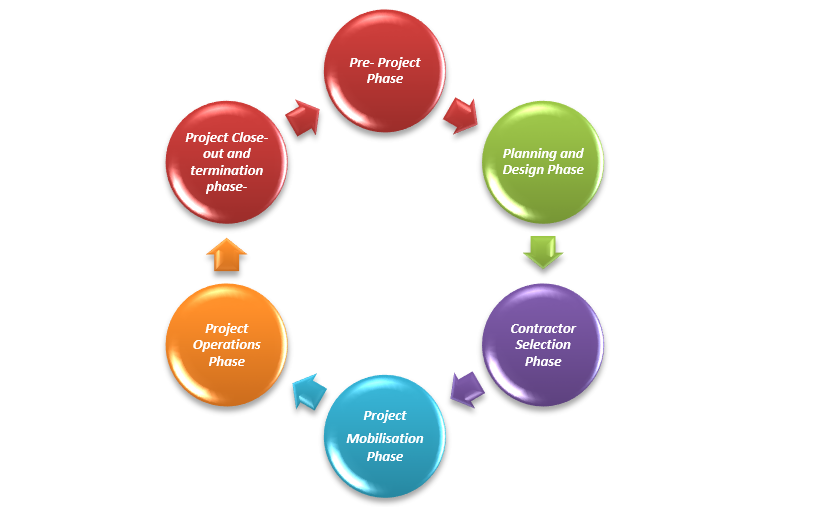Consider any project and you’ll also have to consider any phases within the project. Construction projects have definite phases. IT projects have definite phases. Marketing, sales, and internal projects all have definite phases. Projects—all projects—are comprised of phases. The sum of a project’s phases equates to the project’s life cycle.
The product life cycle begins at the moment the product begins to be used, sold or placed in operation, thus producing the benefits that justified the project in the first place. There may be some overlap between the standard project close-out phase and the initiation of the product usage and thus its product life cycle.
For consumer products, the product life cycle typically has five phases: introduction, growth, maturity, decline, and termination.
There may of course be product improvements (new projects) to extend the product life. If the project produces a new facility, such as a petrochemical processing plant, the product life cycle will consist of these phases: commissioning (usually also an overlapping phase with the project that produced the plant), operation (with periodic maintenance and modification projects interrupting productive operation), decommissioning, and demolition (including any ecological cleanup.)
For an IT software project that produces an information system, the product life cycle phases will include commissioning (placing the system into full operation), operation, and decommissioning (usually replaced by a new system.)
When agile project management methods are in use, there will often be a long period of continuous improvement as new features are added or unforeseen deficiencies are corrected during the project execution phase. In these cases, it may be difficult to know when the original project scope has been achieved and to identify exactly when the project has been closed out and the system (product) operation phase begins.
Purposes of Project Life Cycle Process Models
The purposes of designing and documenting the overall project life cycle process for any project or project category are to:
Enable all persons concerned with creating, planning and executing projects to understand the processes to be followed throughout the life of the project.
Capture and document the best experiences within the organisation so that the processes within each project phase can be improved continually and applied to future, similar projects.
Enable all the project roles and responsibilities and the project planning, estimating, scheduling, monitoring and control methods and tools to be appropriately related to the overall project life cycle management process; this includes most importantly assigning qualified persons to the roles of Project Executive Sponsor and Project Manager at the proper points in the project life cycle phases, as discussed later in this paper.
Enable the effective application of project management software application packages that are integrated with all appropriate corporate information systems.
Six Stages of Project Life Cycle Management
Lots of models for implementing Project Life Cycle Management have been introduced but one of the most common ones is below:

Pre- Project Phase
Here the project objective or need is identified; this can be a business problem or opportunity. An appropriate response to the need is documented in a business case with recommended solution options. A feasibility study is conducted to investigate whether each option addresses the project objective and a final recommended solution is determined. Issues of feasibility and justification are addressed.
Planning and Design Phase
The project solution is further developed considering minute details and necessary steps are planned to meet the project’s objective. In this step, the team identifies all of the work to be done. The project’s tasks and resource requirements are identified, along with the strategy for producing them. This is also referred to as scope management.
Contractor Selection Phase
In anticipation of selecting a contractor, the owner decides whether an open invitation will be issued to all possible vendors or whether only certain contractors will be invited to submit offers and whether any sort of prequalification process will be invoked to limit the number of tenders. On the other side, contractors will have to consider a number of factors in deciding whether they will make the effort to assemble a proposal for a particular project.
Project Mobilisation Phase
After the contractor is selected, a number of activities must be completed before installation work can begin at the project site that includes securing various bonds, licenses and insurances. A detailed program for the construction activities is prepared. The cost estimate should be mandatorily converted to a project budget and the system for tracking actual project costs is also established.
The worksite must be organised, with provisions for temporary buildings and services, access and delivery, storage areas and site security. The process of obtaining materials and equipment to be incorporated into the project must be initiated and arrangements for labour, the other essential resource, must be organised. With the completion of this phase, it is finally time to begin the actual field construction.
Project Operations Phase
During this phase, the implementation phase, the project plan is put into motion and performs the work of the project. It is important to maintain control and communicate as needed during implementation. Progress is continuously monitored and appropriate adjustments are made and recorded as variances from the original plan.
Project Close-out and termination phase
Finally, as the project nears completion, a number of special activities take place before the contractor’s responsibilities are considered complete. There are the various testing and start-up tasks, the final clean up, various inspections and remedial work that may result from them and the process of closing the construction office and terminating the employment of staff. In addition, a myriad of special paperwork is required, including approvals and certifications that allow the contractor to receive final payment, a set of as-built drawings that include all changes made to the original design, operating manuals, warranties and a final report.
How CBIS can help you
Please contact us if you need more details on how our expert team can assist you. We are simply experts in training, consulting and coaching Lean Six Sigma projects.
Attending our Public classroom physically or joining the team virtually from anywhere, according to the training calendar.
A flexible self-paced training for busy people along with our support by a dedicated coach, to solve the disadvantage of one-way online training
Delivering flexible and tailored training for your team and at your premises as a cost-effective solution for your team.


